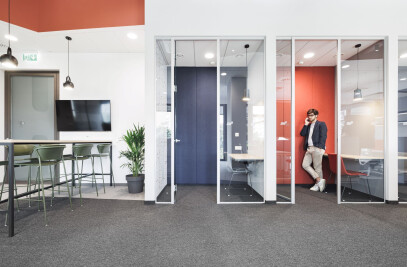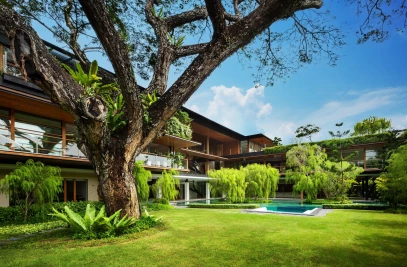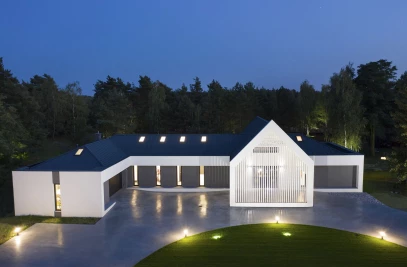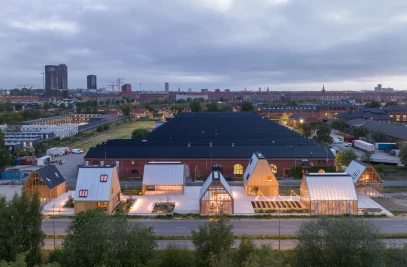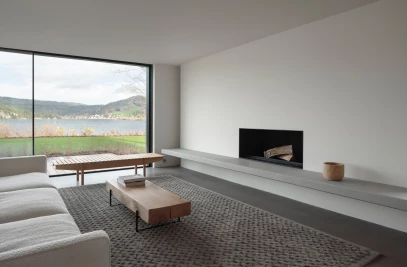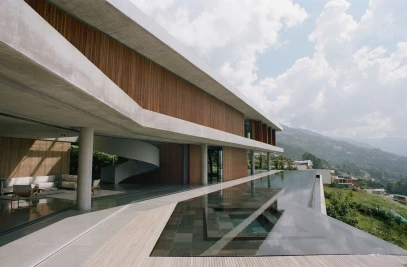Pioneers of mass timber in North America, Michael Green Architecture has recently completed two buildings for the College of Forestry at Oregon State University: the new George W. Peavy Forest Science Center (Peavy Hall) and the A.A. ‘Red’ Emmerson Advanced Wood Products Laboratory. The two buildings, which together form the Oregon Forest Science Complex, offer study and research space for the management and support of forest ecosystems in the 21st century.

The 80,000 square foot George W. Peavy Forest Science Center includes classrooms, computer rooms and laboratories which are anchored around a two-storey atrium. Massive Douglas fir glulam columns are featured alongside floor and shear walls made with locally sourced CLT. The wide stairway of the atrium is constructed with timber glulam beams salvaged from the previous building and doubles as auditorium seating and space for students to gather.
The atrium is directly connected to the Peavy Arboretum, a curated collection of local plant species that acts as a living classroom for forestry students, community and industry. The edge between the building and the adjacent arboretum is blurred to remind students and faculty of their unique and critical role as environmental stewards.

The building’s wood structure design features an innovative seismically resilient rocking shear wall system in response to the high seismic requirements of the site. The first of its kind in North America, the system was designed with technology pioneered in New Zealand after the 2011 Christchurch earthquake. Here, the shear walls are composed of separate sections connected vertically by a post-tension system. This allows the walls to move and self-centre during a seismic event, and for components to be selectively replaced on an as-needed basis after a seismic event occurs.
Furthermore, the George W. Peavy Science Center is part of the SMART-CLT project, a program that involves monitoring the health, structural and occupational performance of solid timber buildings, and analyzing factors that negatively affect their performance during the building’s lifespan. As such, the building has installed 381 sensors that monitor the moisture content of the wood, its internal and external conditions and the transfer of heat. Also monitored is the long-term movement of walls and floors.

The A.A. ‘Red’ Emmerson Advanced Wood Products Laboratory (AWP) hosts research spaces for the development and testing of new wood products and technologies. The building brings together the world of industry and academia under one roof, to improve knowledge of the use of wood in buildings through applied research, product development, verification systems and professional education.

The building structure is a simple and elegant glulam and MPP system that works to achieve the long spans required. The lab space is broken into two compartments: the structural testing bay, which includes a reaction wall and sturdy floor to support heavy structural work, and the testing of structures up to three storeys high. Additionally, there is a production department equipped with advanced robotics and manufacturing equipment.

The design of the AWP building enclosure includes the integration of translucent panels and structural wood panels, resulting in a beautiful daylit high bay lab space that becomes the backdrop for innovation. The glazing system is made with photochromatic glass, and has advanced controls that respond to building orientation and local weather to maximize daylighting while reducing solar heat gain and glare.

Most of the wood used to build the George W. Peavy Forest Science Center (PFSC) and the A. A. ‘Red’ Emmerson Advanced Wood Products Laboratory (AWP) is sourced from Oregon. The junction that connects the two buildings, for example, is constructed in western red alder. The wood was grown in Oregon and processed by Northwest Hardwoods, a company based in Tacoma, Washington. The shear walls and floors were made with cross-layered laminated wood panels of Douglas Fir, worked by D.R. Johnson Wood Innovations, LLC in the city of Riddle, Oregon.

Mass Plywood (MPP) panels, created by Freres Lumber Company Inc., in Lyons, Oregon were used in the A.A. ‘Red’ Emmerson Advanced Wood Products Laboratory, and on the roof of the George W. Peavy Forest Science Center. Most of the products that furnish the buildings are also made from locally grown and processed wood.




























